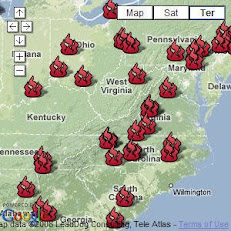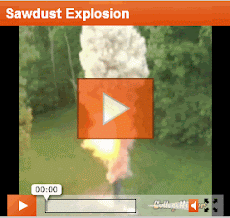 |
| Figure 6. Number of Combustible Dust Related Violations |
Figure 6. "Number of Combustible Dust Related Violations"
OSHA Status Report on Combustible Dust National Emphasis Program (NEP) does not
even note any combustible dust related violations for "
1910.39 Fire prevention plans." How odd especially with requirements of a written
plan on proper handling and storage procedures for hazardous materials,
potential ignition sources and their control, and the type of fire
protection equipment necessary to control each major hazard. In addition
to procedures to control accumulations of flammable and combustible
waste materials in conjunction with procedures for regular maintenance
of safeguards installed on heat-producing equipment to prevent the
accidental ignition of combustible materials.” I guess combustible dust
is not considered a combustible waste material nor a hazardous material?
Congressional Proposed Interim Standard
Since OSHA
1910.39 Fire prevention plans have been ignored regarding combustible dust hazards they will now
be included in the reintroduced combustible dust legislation "
Worker Protection Against Combustible Dust Explosions and Fires Act of 2013," for an OSHA interim combustible dust standard. Elements in an interim
standard will include:
(2)written program that includes provisions for hazardous dust
inspection, testing, hot work, ignition control, and housekeeping,
including the frequency and method or methods used to minimize
accumulations of combustible dust on ledges, floors, equipment, and
other exposed surfaces.
(3) Requirements for engineering controls, administrative controls, and
operating procedures, including means to control fugitive dust emissions
and ignition sources, and the safe use and maintenance of process
equipment and dust collection systems and filters.
(4) Requirements for workplace inspection and housekeeping to prevent
accumulation of combustible dust in places of employment in such depths
that it can present explosion, deflagration, or other fire hazards,
including safe methods of dust removal.
(6) Requirements to provide written safety and health information and
annual training to managers and employees and their representatives,
including housekeeping procedures, hot work procedures, preventive,
predictive, and periodic maintenance procedures, common ignition
sources, and lock-out, tag-out procedure.
NOTE: OSHA
Fire Prevention Plans (FPP) only required if all of your
employees evacuate immediately during a fire emergency (page 15 .pdf) or if one of these
three host standards apply: CFR 1910.1047(h)(1)(iii): Ethylene Oxide, CFR 1910.1050(d)(1)(iii): Methylenedianiline, or CFR 1910.1051(j): 1,3-Butadiene.
Additionally no mention in the 2009 OSHA Status Report on
Combustible Dust National Emphasis Program regarding combustible dust related violations
in failure to have a certified written
Hazard assessment 1910.132(d)(1)
“The employer shall assess the workplace to determine if hazards are
present, or are likely to be present...” Legislators did not forget that
one either in the reintroduced combustible dust legislation with (1)
Requirements for hazard assessment to identify, evaluate, and control
combustible dust hazards.
OSHA Citations: Fire Prevention
Plans (FPP) and Certified Hazard Assessments
Question is how can there be hundreds of combustible dust related incidents
annually with over 500 in 2011 according to a CDPI preliminary analysis of NFIRS data, if the required OSHA written Fire Prevention
Plans (FPP) and certified Hazard Assessments plans are adhered to? Is
it just a paper chase and stakeholders doing nothing more than filing
the required written plans in the office file cabinet?
Federal OSHA citations for the period October 2011 through September 2012 in the Lumber And Wood Products industries, (Except Furniture) there was no Federal OSHA citations for 1910.39 - Fire prevention plans (FPP).
With the over 500 ComDust related incidents in 2011 according to a
preliminary NFIRS analysis, the Lumber And Wood Products industries
experienced over 16% of the incidents. How can there be so many
incidents yet in the same vein FPP is adhered to regarding regular
maintenance of safeguards installed on heat-producing equipment to
prevent the accidental ignition of combustible materials?
This observation is not meant to solely pick on the Lumber And Wood
Products as there are dozens of other diverse industries handling
combustible particulate solids. For example out of the over 12,700
Federal OSHA citations at 2,419 facilities in the manufacturing sector
from October 2011 through September 2012, only two (2) Federal OSHA citations for 1910.39 - Fire prevention plans (FPP)
So the odds of receiving an OSHA citation for FPP in that time period
was 0.016% out of the nearly 13,000 citations.
Conclusion
The problem is intensified when viewing the OSHA website
on combustible dust hazards where, "Federal OSHA standards are mandatory;
they include provisions that address certain aspects of combustible
dust hazards. Some are industry-wide and others and industry-specific."
No mention at all regarding certified written hazard assessment
1910.132(d)(1) nor any note of 1910.39 Fire prevention plans. Additionally, in the OSHA ComDust NEP
numerous OSHA CPL's listed in the reference section yet CPL 2-1.037,
Compliance Policy for Emergency Action Plans and Fire Prevention
Plans excluded. Wouldn't it be prudent for all global stakeholders to implement the protections of hazard assessments and fire protection plans now instead of waiting for the results of proposed combustible dust legislation and regulations?










 RSS Feed Subscribe
RSS Feed Subscribe